By Leah Douglas
(Reuters) - Summit Carbon Solutions, which is trying to build the biggest carbon dioxide capture pipeline in the United States to transport and bury greenhouse gases, has repeatedly pledged its project will not be used by drillers to boost output from oil fields.
But Summit has a different message for prospective clients, including North Dakota’s oil sector, according to a Reuters review of state regulatory filings and recordings of public appearances by company executives: if you want to use our project for enhanced oil recovery (EOR), where gas is pumped into oil fields to increase production, just write a check.
The dual messages illustrate Summit's efforts to court broad support for its $5.5 billion project, which could capture as much as 18 million metric tons of CO2 annually from 57 Midwest ethanol plants and store it underground at a site in North Dakota.
Whether Summit succeeds at its goal to break ground in 2025 and begin operations in 2026 is a major test for carbon capture and storage, a key tool in the fight against climate change but which faces obstacles like unproven scalability and public apprehension.
The ethanol industry wants Summit to sequester its carbon to drive down its carbon intensity and draw lucrative tax credits from state and federal clean fuel programs.
But the oil industry wants to use the pipeline for EOR, reflecting a belief among drillers in North Dakota’s Bakken that oil recovery is necessary to reverse the once-booming region’s flagging output. North Dakota oil players launched the group Friends of Ag and Energy in December to promote carbon pipelines like Summit's, including through thousands of dollars of radio ads.
With the Summit project, "the potential is there, the size of the prize in the Bakken is significant, and ultimately, I see a tremendous long-term opportunity," North Dakota Petroleum Council (NDPC) president Ron Ness told Reuters.
Summit has long maintained, in both sworn testimony to state pipeline regulators and on its website, that it does not intend to use its project for EOR.
"The Summit Carbon Solutions project will not be used for enhanced oil recovery," the website reads. "Summit does not intend to ship CO2 for use in EOR," the company told the Iowa Utilities Board (IUB) last August.
Environmental groups generally oppose EOR because of its potential to extend the life of the fossil fuels industry.
But more recently, Summit officials have indicated that using the pipeline to ship carbon for boosting oil production is a future likelihood.
"Today, we don’t have any shippers who want to ship CO2 for EOR. When that changes, we will likely move it for that purpose," said Wade Boeshans, Summit's executive vice president, at a December 20 event held by Friends of Ag and Energy in Bismarck, North Dakota.
Summit attorney Bret Dublinske told the IUB in a January 19 filing that the company "does not ultimately control" whether future customers would use the pipeline for EOR.
And Bruce Rastetter, chairman of Summit's parent company Summit Agricultural Group, also said on a North Dakota radio show on February 7 that the company is open to EOR.
Summit CEO Lee Blank said the company’s messaging on EOR is consistent.
"The front-end goal of this company is the ethanol industry and the sequestration of carbon, and it will be that until the market tells us to do anything different," he said.
The company is also contractually obligated to sequester all carbon it captures at ethanol plants who have signed on with the company, Blank said.
OIL INDUSTRY ALLIES
North Dakota's oil production peaked in late 2019 after a nearly decade-long drilling boom that made it one of the country’s top crude suppliers, and it has yet to recover, according to data from the Energy Information Administration.
The state will need as much as ten times more CO2 than it can capture from stationary sources to free billions of barrels of oil trapped in Bakken fields, said John Harju, vice president for strategic partnerships at the University of North Dakota's Energy and Environmental Research Center.
"Importing CO2 via pipeline is something that I think at the end of the day is going to be necessary," Harju said.
Summit has faced setbacks in securing state permits, including in North Dakota, and land easements from some landowners along its route over safety, land rights, and environmental concerns.
In a bid to build public support, Friends of Ag and Energy advertised on six North Dakota radio stations between early December and February, according to records maintained by the Federal Communications Commission. Invoices show that in December, the group paid a total of $16,366 for 487 ads across the six stations. Invoices for other months were not available.
The group's chair, Kathleen Neset, is a North Dakota oil sector consultant and member of the North Dakota Petroleum Council board. Neset did not respond to an interview request.
Its parent organization, Primus Incorporated, counts influential figures in the state oil industry as its board members and donors, according to the group's public filings.

Summit's current focus on sequestration is in part due to the 45Q tax credit program, expanded by the Inflation Reduction Act, which offers $85 per ton of sequestered carbon and just $50 per ton for EOR.
A shift in that policy could alter the company's priorities around EOR, executives and oil industry players said.
